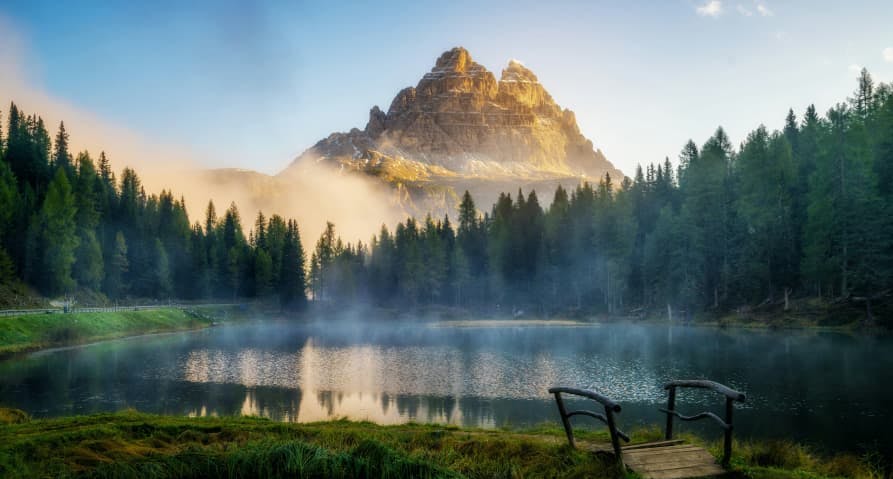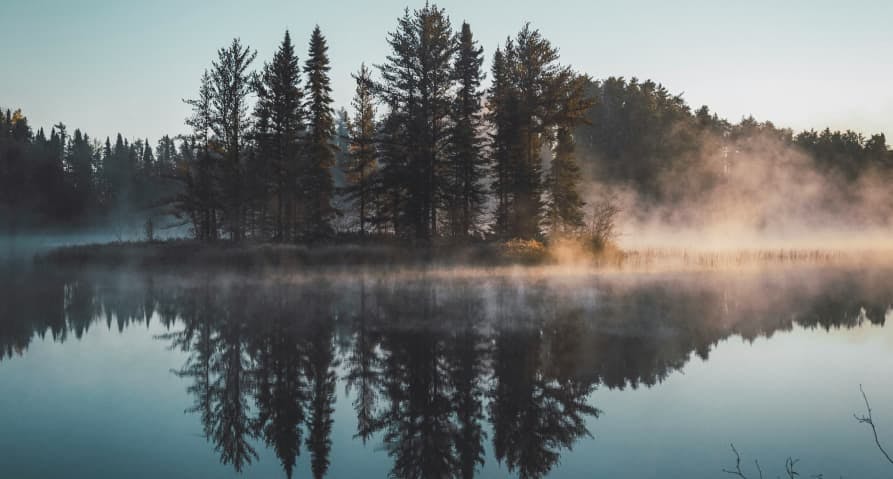ESG / CSR
Industries
Forests and Climate Change: How Are They Related?



You’ve probably heard that planting trees is one of the best ways to mitigate the effects of global warming, but how are forests and climate change interconnected?
Unbeknownst to most people, forests and climate change are directly related to one another – as trees can help to absorb excess carbon dioxide emissions, and climate change has a negative impact on the livelihood of forests and their subsequent ecosystems and surrounding wildlife.
In this article, we’ll explain how forests and climate change are related, how deforestation affects climate change, and the future of forests and climate change.
How are forests and climate change related?
Forests and climate change are related as forests can help to reduce the rate of climate change by absorbing excess carbon dioxide emissions from the atmosphere, and climate change threatens the vitality of our forests, their ecosystems, and surrounding wildlife.
Forests are an important part of our planet and our efforts to reduce the negative effects of climate change, such as by helping to absorb rainwater, avoid the worst effects of flooding, preserving soil and water quality, and more.
Here are a few more reasons why forests and climate change are related:
- Forests can help to remove toxic pollutants that are currently airborne as a result of climate change, meaning that forests and climate change are interconnected in terms of air pollution;
- Forests can prevent the need for excessive air conditioning, as healthy forests can help to regulate high temperatures in dense, urban areas – such as New York City or Tokyo.
- Forests serve as a home to thousands of species, and no matter how small these organisms are – all of them play a role in helping to support biodiversity, and therefore – working to prevent climate change.
- Forests provide many resources we use in our daily lives – such as wood for furniture, drinking water, food, fuel, and even bio-products. Therefore, as we continue to pollute the planet at an unprecedented rate – we continue to put some of our most valuable resources at stake, as forests are directly impacted by climate change.
👉 Overall, forests and climate change are interconnected seeing as forests help to mitigate climate change – but rising global temperatures can impact the quality of resources provided by forests, which in turn makes it more difficult for forests to help offset climate change.

How does deforestation affect climate change?
Deforestation affects climate change because when trees are cut down, more carbon dioxide is released into the atmosphere. This means destroying forests isn’t only bad for the wildlife living there or for society – but for climate change, too.
Here are a few more reasons why deforestation can elicit a negative effect on climate change:
- Forests Can Help Lessen the Impact of Natural Disasters – Forests can have a direct influence on rainfall patterns, which ultimately means that forests can help to prevent flooding.
- Destroying Forests Indirectly Support High-Emitting Industries – Many forests are destroyed as a result of setting up farms for meat, soy, and palm oil – which means that climate change is not only spurred by cutting down these trees to develop these agricultural sites, but supports high-emitting industries such as the meat and palm oil industries.
- Compromised Biodiversity – Forests are home to millions of various plants, animals, and microorganisms – all of which can help protect forests and provide mankind with valuable resources. However, deforestation often destroys the homes these species dwell in – putting a halt to imperative processes in nature such as pollination and seed dispersal. When these natural processes can no longer be carried out, it can result in pests – which affects agriculture.
- Indirect Cause of Urbanization – The more densely populated cities are, the more cause for concern they become in regards to climate change – and deforestation continues to aggravate this very issue, as many indigenous people are forced to flee their native land following deforestation.
- Cause for Concern with Carbon Sequestration – Most people are unaware that large forests and climate change are related, seeing as trees act as carbon sinks – which absorb carbon dioxide from the atmosphere. However, when trees are cut – the carbon dioxide they have been storing is released back into their air – which accentuates the current negative impacts associated with climate change.
💡 Did you know that the Amazon rain forest in Brazil is almost the size of the United States? Knowing this, it’s easy to understand how devastating it is that 20% of the Amazon rain forest has been lost as a result of deforestation – and the negative impacts that have ensued as a result.

How does climate change affect forests?Why is it difficult to go green?
Climate change has a direct impact on forests since rising temperatures, reduced air quality, droughts, and more impact the sustenance of wildlife and biodiversity in forests – all of which impacts society as a whole.
Climate change has a profound effect on forests, such as by:
- Forest Migration – Climate change is, and will continue, to make several regions of the world inhabitable for tree species – to the extent that many types of trees will migrate north to avoid excessively warm and drier climates.
- Wildfires – People aren’t the only ones to have lost their homes as a result of wildfires – but plants and animals, too. Wildfires continue to put forests in harm's way, and the saddest part is – we as a species are continuing to create perfect conditions for future wildfires to occur. This is devastating to imagine, as several places across the world have been impacted by wildfires – and the worst is still yet to come.
- Droughts – Almost everyone knows that trees need sunlight and water to thrive, but what most people don’t realize is that dehydrated trees aren’t as able to absorb carbon dioxide through their stomata. Droughts are becoming prominent across the globe, such as with the Colorado River drying up and the current drought in Spain.
- Increased Pests – Many people are unaware of the fact that pests, such as mosquitoes, are only going to grow more prominent and plentiful in the midst of climate change. These pests can have an impact on the species and wildlife living in forests.
👉 Climate change will continue to impact the health and prosperity of forests, which in turn – will prove unhelpful in the global fight to reduce emissions and the miscellaneous negative effects of skyrocketing temperatures.

What would happen with forests and climate change if we planted more trees?
If we made a bigger effort to preserve forests and even start new forests in suitable regions of the world, we could create a substantial difference in the fight against climate change.
Several organizations, such as REDD+ and the UNDP, are working to ensure forests are protected by vouching for reforestation projects and mitigating future deforestation – but what are some of the challenges of working to ensure the relationship between forests and climate change remains beneficial for all?
Here are some of the challenges of working to plant more trees and preserve forests and climate change:
- Inconsistent Climate Conditions – Droughts, wildfires, and floods can make it challenging to plant new trees – as soil growth and migrating species could impact the vitality of those trees and eventual forests later on down the road.
- Limited Financial Resources – Reforestation projects are costly and difficult to find funding for, which makes it challenging to pontificate the importance between forests and climate change – let alone to rectify the existing issues forests and climate change have created for one another.
- Conflict Over Land Usage – Businesses and entire countries alike will often fight for land in the event it proves suitable for agriculture or infrastructure development – which can make it difficult to secure land that would be better put to use as a future forest. Therefore, one of the biggest challenges to planting more trees and ensuring a positive relationship between forests and climate change is the difficulty to make effective, collaborative decisions between various parties.
- Need for Consistent Monitoring & Management – Planting trees in hopes of starting a new forest is no easy task. Think of new trees as babies or puppies: they require utmost attention and care to ensure they grow up to be healthy and functional adults, or in this case – viable trees a part of a forest. This requires exceptional data collection and effort to manage and monitor growing forests, both of which not all organizations have the time or ability to do.
- No Support From Locals – Even though most people are ambivalent to planting more trees, having support would help to propel future reforestation projects. This would encourage individuals, governments, and business alike to allocate more resources to planting trees and promoting a beneficial relationship between forests and climate change.
💡 It would be beneficial to plant more trees and preserve existing forests, but climate change is making it difficult to fund these pivotal reforestation projects.

How can we prevent forests and climate change from suffering as we move forward?
Forests and climate change will both continue to get worse as the negative effects of global warming prevail, but we can all make an effort to support reforestation, preserve existing forests, and fight against climate change.
Some of the ways forest fires and climate change will continue to hinder one another suffuse into business prospects, too. This is because businesses looking to start new industrial processes through deforestation will continue to decrease the amount of available carbon sinks in our natural environment.
Here are some ways we can prevent forests and climate change from getting worse moving forward:
- Switching to the use of renewable energy
- Purchasing carbon credits or carbon offsets to plant new trees
- Ensuring your company is up-to-date on current environmental regulations
- Refraining from purchasing cosmetics, clothes, or other products which harm forests
- Create a sustainable strategy for your business to effectively reduce scope emissions
Remember – forests and climate change are currently having a negative effect on one another, but it doesn’t have to be that way! If forests are properly protected, it can help to reduce the amount of carbon dioxide emissions in our atmosphere and mitigate climate change – and if we fight against climate change, our forests have a better chance of helping us in this global battle.
The relationship between forests and climate change doesn’t have to be toxic, but it does need your help if it’s ever going to change.
What About Greenly?
If reading this article on forests and climate change and how they’re interrelated has made you interested in reducing your carbon emissions to further fight against climate change – Greenly can help you!
At Greenly we can help you to assess your company’s carbon footprint, and then give you the tools you need to cut down on emissions. We offer a free demo for you to better understand our platform and all that it has to offer – including assistance with boosting supplier engagement, personalized assistance, and new ways to involve your employees.
Click here to learn more about Greenly and how we can help you reduce your carbon footprint.




